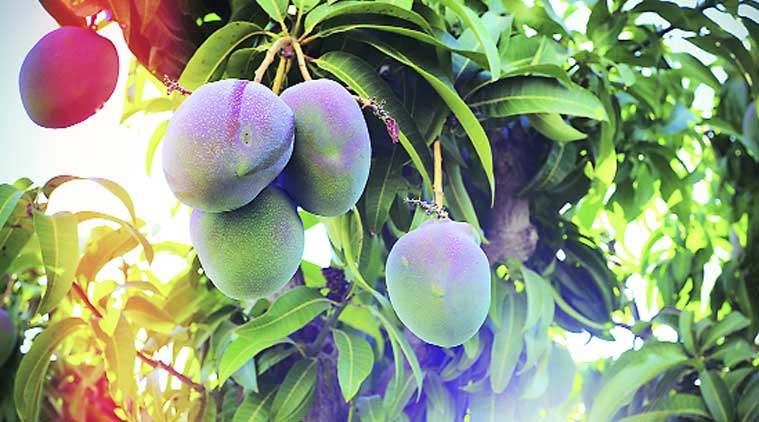- India
- International
Maharashtra: Shifting weather pattern plays spoilsport; farmers’ efforts fail to bear fruit
Maharashtra’s horticulturists have had a good run since the 1990s when subsidies under the Employment Guarantee Scheme were offered to small and marginal farmers.
 Farmers turn to horticulture because one year’s reverses are easily fixed by the following year’s good crop.
Farmers turn to horticulture because one year’s reverses are easily fixed by the following year’s good crop.
There was a time when a farmer’s worries peaked once annually over a failed monsoon or a flood. “Now we get strange weather conditions on one day of every month,” grumbles Kiran Wagh, 35, of Tembhe village in Nashik’s Satana Taluka. “Cloudy, overcast, humid — perfect weather for bacterial blight.” Wagh grows pomegranates on 18 acres of drip-irrigated land in Tembhe, his family having switched over to horticulture over two decades ago. “And there are no aid packages for blight, remember that,” he continues, launching into a tirade against the state government’s apparent disconnect with farm challenges.
Wagh received Rs 1,000 from the government for crop damage due to hail, a sum he calls a joke, but his losses are actually minimal — he invested in good plastic covering for each of his 2,000-odd trees. “But 30 per cent of the pomegranate crop in Tembhe was completely destroyed, in neighbouring villages the damage ranges from 50 per cent to 100 per cent.”
Satana Taluka accounts for 10,000 acres of pomegranate trees, and Wagh says farmers are now wary of further investment in the orchards after repeated damage due to unseasonal rain and hail in 2013 and 2014, with the two rounds of hailstorms in 2015 proving to be the most cruel blow.
[related-post]
That familiar tale is now repeated across the state. Appasaheb Tikhe, a watermelon farmer in Kaij talk of Beed, lost 13 acres of fruit to the hailstorm. “There wasn’t one fruit left to salvage for the market,” he says. Deepak Deshpande, a local journalist and small farmer in Kaij, says his 125 kesar mango trees produced absolutely nothing this year. Farmers in the kesar mango export zone of Aurangabad-Beed-Jalna are exporting next to nothing this year.
Horticulturists across the state, especially in north Maharashtra and Marathwada, are reporting seriously dented yields this year. Maharashtra’s director for Horticulture Sudam Adsul says mango and grape are the worst affected, exports down 50 per cent from last year. Of the 2.4 lakh hectares that saw crop damage in the first two weeks of March this year as hailstorms hit twice, the worst damage was to wheat and gram, and next to grapes, pomegranate and mangoes. And, with mango exports from Maharashtra already on the decline over the past three years, this year’s exports of both, the Konkan belt’s Alphonso and the Aurangabad-Jalna belt’s Kesar mango will be minimal.

Maharashtra’s horticulturists have had a good run since the 1990s when subsidies under the Employment Guarantee Scheme were offered to small and marginal farmers as well as to SC/ST farmers cultivating fruits. From 2.42 lakh hectares in 1990-91, horticulture is now practised on 18.43 lakh hectare as of December 2014. The National Horticulture Mission in 2005-06 saw a further jump in land under fruit cultivation.
Prabhakar Chandane, one of western Maharashtra’s major pomegranate growers, says the math is simple enough for farmers: Five to seven times the profit in a good crop year compared to growing maize or wheat. “Especially with pomegranate which needs the least water.” Chandane is from Sangola in Solapur, a drought-prone region, and shifted from grape to pomegranate as it was less water intensive.
Chandane has watched keenly as pomegranate cultivation leaped since he started growing the fruit in 1974 when the market price was Rs 5 a kg, considered an excellent price. In 2013-2014, pomegranate accounted for 1.73 lakh hectares with a production of nearly 7 tonnes per hectare. “Farmers are gravitating towards fruits for the obvious advantages, but we’re now at a point when we know the pitfalls. The government must invest in research,” he says. Solapur is home to a national research centre for pomegranate cultivation, but he says there is little help by way of tackling bacterial blight or wilting. Single’s pomegranate farms have not seen much damage, but he expects bacterial blight to be a major crisis in the coming year.
In 2014 summer as well, 50 per cent of kesar mango was lost due to untimely rains. Trimbak Pathrikar of the Aurangabad Mango Growers Association says two years of losses have turned once-prosperous orchard owners to seek loans. “Farmers turn to horticulture also because one year’s reverses are easily fixed by the following year’s good crop. But if we have year after year of unpredictable weather, it’s just scary,” he says.
Apr 24: Latest News
- 01
- 02
- 03
- 04
- 05







































